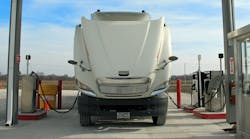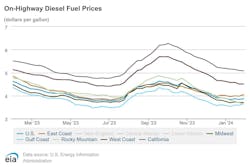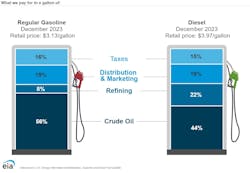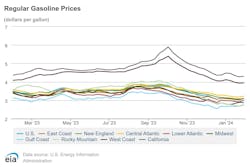After a steady decrease in diesel prices through the end of 2023, the U.S. Energy Information Administration has logged an erratic start to 2024. The up-and-down pattern continued the week of Jan. 29. EIA reported that average national on-highway diesel fuel prices ticked up two cents to $3.867 per gallon. But pump prices remain 75 cents cheaper than the national average a year ago.
Most regions across the U.S. saw an increase in diesel prices, save for the Rocky Mountain region and California. The Rocky Mountains saw a dip of 5 cents (to $3.645 per gallon), and the Golden State dropped 1 cent (to $5.078 per gallon). The Central Atlantic sub-region also experienced a decrease in diesel prices, although it was less than a cent, whereas the Midwest remained the same.
On a positive note, price increases across the country were minimal, with the highest price increase of 9 cents occurring in the Lower Atlantic sub-region, where prices reached $3.949 per gallon. Despite being 3 cents behind the Lower Atlantic, the East Coast saw an increase of 6 cents to $4.043 per gallon, as did the Gulf Coast with a rise to $3.644 per gallon.
Even with these changes, the Gulf Coast still has the least expensive diesel in the U.S.—only 1 cent less than the Rockies. Meanwhile, California remains the most costly.
See also: Diesel prices decrease nationwide
On a more granular level, the EIA also broke down the country's fuel prices by component cost. As of December 2023, when trucking's primary fuel cost was $3.97 per gallon, crude oil made up a bit less than half the fuel price at roughly $1.746. Refining costs were next at 87 cents, distribution and marketing at 75 cents, and taxes accounted for 59 cents.
Compared to EIA’s prices, the AAA motor club logged the current diesel average at $3.906 per gallon, 4 cents more expensive than the EIA, and barely more expensive than last week’s average of $3.905. However, this is still better than last year’s average of $4.013.
Gasoline prices up 3 cents, down 40 cents year-over-year
Regular gasoline prices across the U.S. rose almost across the board. As of Jan. 29, the nationwide average is $3.095, 3 cents higher than last week but still 40 cents cheaper than last year. The only exception to the price rise was the Midwest region, which dropped 1 cent to $2.872 per gallon.
Otherwise, the most significant gasoline price hikes were 6 cents in the East Coast, 8 cents in the Lower-Atlantic sub-region, and 6 cents in the Gulf Coast and Rocky Mountain regions.
California is still the most expensive state or region to buy gas after a 2-cent rise in price to $4.294, while the Rocky Mountain region is the cheapest at $2.732, 2 cents cheaper than the Gulf Coast.
The AAA noted a gasoline average ($3.107) similar to the EIA, a 3-cent price increase from last week. This is still better than this time last year, however, where prices were 40 cents more expensive at $3.509.
According to a press release from AAA, the current gasoline market could be due to a low demand for gas paired with slightly higher oil costs.
“Like watching dogs play chess, not much is happening,” said Andrew Gross, AAA spokesperson. “The national average for gas will likely maintain a glacial grind higher for the immediate future.”
This article was originally published on FleetOwner.com.







